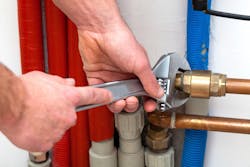Sometimes it becomes necessary to expand into new markets or add another trade if you want to hit your growth objectives. Here are the seven steps to follow when you want to add new trade.
No. 1: Make sure you need to expand horizontally. Adding a trade means expanding horizontally. You could add HVAC, pool and spa, electric or any number of trades. On the surface, it appears seductively easy. Add the trade and double the revenue with your same customer base. Maybe do better than that if the added trade involves a heavy material component like HVAC and pools.
Yet, it rarely works that well and it might be a disaster. Service may be service, but each trade carries its own nuances. The technology can differ. Field service personnel may have vastly different attitudes about pay and selling. While you are focused on bringing the new trade up to speed, you can take your eye off your plumbing business.
Most plumbing companies have lots of room to grow plumbing within their existing markets. Before you expand horizontally, make sure are acting for the right reasons and not “bright, shiny object syndrome.”
Most plumbing companies have lots of room to grow plumbing within their existing markets.
No. 2: Consider geographic expansion. Another option to consider is geographic expansion. Open up a satellite operation in another town. Rent a small space in a public place like a busy strip center or Main Street office. Hire a well-connected person to act as your ambassador. This should be someone who is active in the community, active in a church, and involved in lots of charitable work. The ambassador’s role is to spread the word about your business.
Start with a single truck for the satellite operation. Use your existing dispatching, bookkeeping and so on. Work with a supplier to deliver parts replenishments.
The downside of geographic expansion is it can be hard to manage since you are not “right there,” on top of things. You also have to build your brand from scratch. On the other hand, you are still operating in the trade you know.
No. 3: Consider adding specializations within plumbing. Before venturing completely outside the trade, see if there’s more you can do within it. For example, some plumbers have focused on adding trenchless pipe relining. Since few of their competitors have the technology, they face less competition and greater profitability.
You can also shift to a different segment of the trade by targeting commercial if you are primarily residential. You can even work on specializations, such as restaurant drain cleaning. Or, you can work with custom home builders.
The advantage is you are staying with the trade you know. Just be careful you fully understand differing business practices in the segment. For example, commercial customers may not be C.O.D. and might need corporate approval to pay.
No. 4: Pick the trade. If you conclude that you need to bolt on a new trade, the next step is to decide which one. Obviously, if you have experience or a key manager has experience with one, then that may be the logical choice.
Licensing will be critical. Someone will need to hold a license and you need to be certain that the license holder is not in a position to hold you hostage. Fortunately, licensing for most trades is less rigorous than plumbing. It’s good to pick one where you have a good chance of getting licensed quickly.
Another factor in the trade selection is how reasonable it is for your customers to associate that trade with you existing company. If the association is not there, you will need to create a new and separate brand.
Another factor in the trade selection is how reasonable it is for your customers to associate that trade with you existing company.
Finally, look at the opportunity for the trade. Many plumbing contractors expand into HVAC because people are comfortable associating the two trades and HVAC carries a heavy material component, which results more gross profit dollars per hour of labor.
No. 5: Do your homework. Before you jump, due diligence is required. Subscribe to the trade’s magazines. For example, if you are considering HVAC, subscribe to Contracting Business. Start reading online articles about the trade. Join a local trade association and find someone who is willing to help you. Even though you might be a competitor, someone will be secure enough to offer a helping hand. It’s also a good idea to seek out online forums and resource banks.
No. 6: Assemble your team. At first, you will need a field service person and a manager. They might be one and the same. Your team also needs supporters. Find an industry consultant who will work with you, even if it is only over the phone for a half hour each week. As mentioned above, a good resource bank if you can find one, will be invaluable.
No. 7: Communicate, communicate, communicate. When you are ready to launch and for years after, the key will be communication. You have got to let your existing customers know you are now providing the new services. You need to let them know again and again and again. It needs to be on your trucks, on your building, in your literature, on your business cards, on your invoices, something your call takers say, and in every communication. Even so, it will take your existing customers years to figure out you have added the trade. They represent your best target.
Matt Michel is CEO of the Service Roundtable. The Service Roundtable provides forums, support literature, and consultations. Visit www.ServiceRoundtable.com.
About the Author
Matt Michel
Chief Executive Officer
Matt Michel is CEO of the Service Roundtable (ServiceRoundtable.com). The Service Roundtable is an organization founded to help contractors improve their sales, marketing, operations, and profitability. The Service Nation Alliance is a part of this overall organization.
